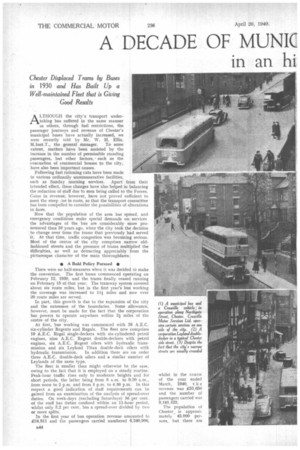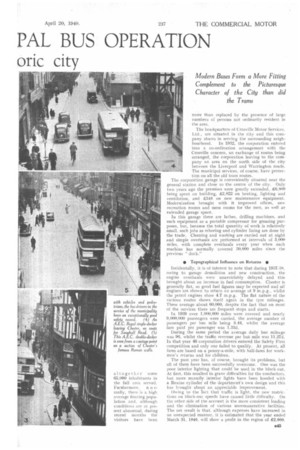A DECADE OF MUNIC PAL BUS OPERATION
Page 62

Page 63

If you've noticed an error in this article please click here to report it so we can fix it.
in an hi
oric city
Chester Displaced Trains by Buses in 1930 and Has Built Up a Well-maintained Fleet that is Giving Good Results
Modern Buses Form a More Fitting Complement to the Picturesque Character of the City than did the Trams
ALTHOUGH the city's transport undertaking has suffered in the same manner as others, through fuel restrictions, the passenger journeys and revenue of Chester's municipal buses have actually increased, we were recently told by Mr. W. H. Ellis, M.Inst.T., the general manager. To some extent, matters have been assisted by the increase in the number of permissible standing passengers, but other factors, such as the evacuation of commercial houses to the city, have also been important causes.
Following fuel rationing cuts have been made in various ordinarily unremunerative facilities, such as Sunday morning services. Apart from their intended effect, these changes have also helped in balancing the reduction of staff due to men being called to the Forces. Gains in revenue, however, have not proved sufficient to meet the steep .ise in costs, so that the transport committee has been compelled to consider the possibilities of alterations in fares.
Now that the population of the area has spread. and emergency conditions make special demands on services the advantages of the bus are considerably more pronounced than 10 years ago, when the city took the decision to change over from the trams that previously had served it. At that time, traffic congestion was becoming serious. Most of the centre of the city comprises narrow oldfashioned streets and the presence of trams multiplied the difficulties, as well as detracting appreciably from the picturesque character of the main thoroughfares.
• A Bold Policy Pursued • There were no half-measures when it was decided to make the conversion. The first buses commenced operating on February 12, 1930, and the trams finally ceased running on February 15 of that year. The tramway system covered about six route miles, but in the first year's bus working the coverage was increased to 14 miles and now over 20 route miles are served.
In part, this growth is due to the expansion of the city and the extension of the boundaries. Some allowance, however, must be made for the fact that the corporation has powers to operate anywhere within 3i miles of the centre of the city.
At first, bus working was commenced with 16 A.E.C. six-cylinder Regents and Regals. The fleet now comprises 10 A.E.C. Regal single-deckers with six-cylindered petrol engines, nine A.E.C. Regent double-deckers with petrol engines, six A.E.C. Regent oilers with hydraulic transmission and six Leyland Titan double-deck oilers with hydraulic transmission. In addition there are on order three A.E.C. double-deck oilers and a similar number of Leylands of the same type.
The fleet is smaller than might • otherwise be the case, owing to the fact that it is employed on a steady routine. Peak-hour traffic rises only to moderate heights and for short periods, the latter being from 8 a.m. to 9.30 a.m., from noon to 2 p.m. and from 5 p.m. to 6.30 p.m. in this respect a good indication of staff requirements can be gained from an examination of the analysis of spread-over duties. On week-days (excluding Saturdays) 56 per cent. of the staff has duties confined within an 11-hour period, whilst only 3.2 per cent, has a spread-over divided by two or more splits.
In the first year of bus operation revenue amounted to 134,911 and the passengers carried numbered 6,540,006, more than replaced by the presence of large numbers of persons not ordinarily resident in the area.
The headquarters of Crosville Motor Services, Ltd., are situated in the city and this company shares in serving the surrounding neighbourhood. In 1932, the corporation entered into a co-ordination arrangement with the Crosville concern, an exchange of routes being arranged, the corporation leaving to the company an area on the north side of the city between the Liverpool and Warrington roads. The municipal services, of course, have protection on all the old tram routes.
The corporation garage is conveniently situated near the general station and close to the centre of the city. Only two years ago the premises were greatly extended,. £6,809 being spent on building, £2,822 on heating, lighting and ventilation, and £249 on new maintenance equipment. Modernisation brought with it improved offices, new recreation rooms and mess rooms for the men, as well as extended garage space.
. In this garage there are lathes, drilling machines, and such equipment as a portable compressor for greasing purposes, but, because the total quantity of work is relatively small, such jobs as reboring and cylinder lining are done by the trade. Cleaning and washing are carried out at night and simple overhauls are performed at intervals of 5,000 miles, with complete overhauls every year when each machine has normally covered 30,000 miles since the previous " dock."
• Topographical Influence on Returns • Incidentally, it is of interest to note that during 1937-38, owing to garage demolition and new construction, the engine overhauls were unavoidably delayed and this brought about an increase in fuel consumption. Chester is generally flat, so good fuel figures may be expected and oil engines are shown to return an average of 9 m.p.g., whilst the petrol engines show 4.7 m.p.g. The fiat nature of the various routes shows itself again in the tyre mileages. These average about 60,000, despite the fact that on most of the services there are frequent stops and starts.
In 1939 over 1,000,000 miles were covered and nearly 9,000,000 passengers were carried, the average number of passengers per bus mile being 8.44, whilst the average fare paid per passenger was 1.33d.
During the same period the average daily bus mileage was 96, whilst the traffic revenue per bu mile was 11.27d. In that year 46 corporation drivers entered the Safety First competition and only one failed to qualify. At present, all fares are based on a penny-a-mile, with half-fares for workmen's returns and for children.
The past year has, of course, brought its problems, but all of them have been successfully overcome. One was the poor interior lighting that could be used in the black-out. At first, this resulted in grave difficulties for the conductor3, but more recently interior lights have been hooded with a Rexine cylinder of the department's own design and this has brought about an appreciable Improvement. Owing to the tact that traffic is light, the new restrictions on black-out speeds have caused little difficulty. On the other side of the account is the more consistent loading and the elimination of various unremunerative facilities. The net result is that, although expenses have increased in an unexpected manner, it is estimated that the year ended March 31, 1940, will show a profit in the region of £2,000,




































































































